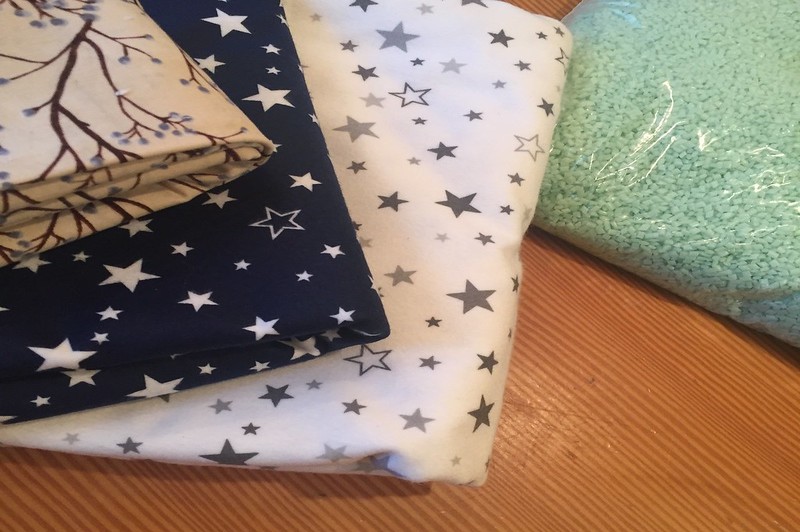It is helpful for you to know how to make a weighted sensory blanket, especially if you suffer from anxiety leading to sleep problems. This is why we’ve written two ways to make a weighted blanket for you or someone you know. So read on and enjoy!

Steps In Making A Weighted Blanket That Is Sensory Friendly
Step #1. Prepare the materials
For this project, the materials you need are a sewing machine, poly pellets, fabric, thread, and scissors. For the fabric, you can use duvet covers or receiving blankets.
Step #2. Start stitching
Sew the three sides of your fabric first. Make sure one side isn’t stitched; that is where you will put the pellets in. After stitching the sides, stitch columns on the blankets with four inches of space between each stitch.
If your blanket is huge, you can opt to leave two sides without stitches and proceed to make a center seam. This way, you will work from the center to the ends of your blanket. This is to ensure that you will be able to fill your large blanket accordingly.
Step #3. Add the pellets
Prepare the pellets and fill each column or row of your stitched blanket with shells. Calculate how many shells you can put in each square of your blanket by dividing the grams needed (concerning body weight) from the number of squares.
Step #4. Stitch again
After putting the pellets in the blanket, stitch across and make a row. Fill the next part with shells, then stitch another row. Repeat this until you reach the ends of the blanket.
Afterward, finish the ends of your blanket by binding them or serging them. After that, it’s up to you!
How to calculate the weight for the weighted blanket?
For kids, the weight of the blanket should not exceed 15% of their body weight. About 10% plus 1-2 pounds is okay for children. For adults, it should weigh about 5-10% of their ideal body weight.
Heavier blankets are known to be beneficial to some. However, it’s better to stick to the calculation mentioned above to be on the safe side. Also, remember never to cover your head with a weighted blanket.
Who benefits from weighted blankets?
About 40 million adults suffer from anxiety every year. One of the common symptoms of anxiety is hyperventilation and increased heart rate, which weighted blankets can help with.
In addition, through pressure therapy, the weighted blanket induces calm in the person with stress as it makes them feel hugged or swaddled. Other people who can benefit from weighted blankets suffer from sleep disorders, ADHD, and Autism. Although there are different mechanisms about how weighted blankets help these people, in the end, they provide comfort from overstimulation.
Steps In Making A No-Sew Weighted Blanket
Step #1. Prepare the materials
For this weighted blanket, you need an alternative down blanket, stick-on velcro, a bag of rice, and double-zipped bags.
Step #2. Lay your blanket
Lay your blanket on a flat surface first, then mark the squares you plan on adding weight to. You can opt to add weight to every other square or add weight on all the squares. This will depend on your resources, after all.
Step #3. Snip a rectangle
Snip a rectangle hole on the squares you plan on adding weight to. Then, cut a piece of your stick-on velcro.
Make sure that it is slightly bigger than the rectangle strip you have, and do this with every square you plan on filling. Let it sit overnight. Fabric glue is also an option if you don’t want to use velcro.
Step #4. Fill the squares
Fill your double-zipped bags with rice appropriate to the weight needed for the blanket. Ensure that the bags are without air, then insert them into the squares.
Make sure they are nice and flat, then close up the velcro. Continue doing this until you have filled and closed every square. After this, you’re done!
What can you use to fill a weighted blanket?
As mentioned above, you can use poly-pellets or even rice as filling for your weighted blanket. The downside with poly pellets is that they may feel bumpy. Likewise, rice can degrade over time and may even attract insects.
The advantage of poly pellets, however, is that they’re hypoallergenic and versatile. Meanwhile, rice is organic and budget-friendly.
So, what would be the perfect filling for a weighted blanket? Another choice for fillers would be glass beads.
They are expensive but are more environmentally friendly than poly pellets and hypoallergenic, and machine washable. These are also ideal for those with severe sensory and auditory sensitivities.
Conclusion
Blankets offer comfort in more ways than one, and this has been proven in this article on how to make a weighted sensory blanket. We’ve included additional information on what kind of fillers you would need and how it comforts people with sensory problems, so do what you will with that information.
